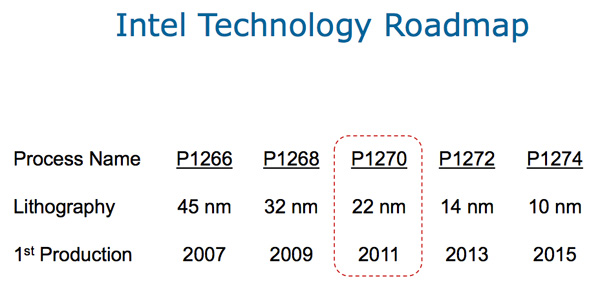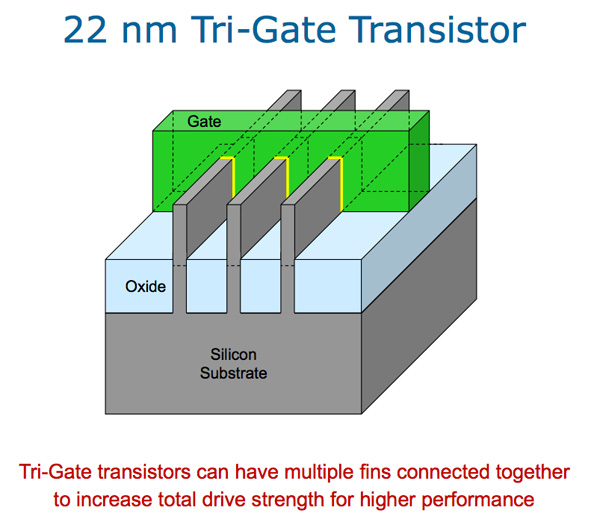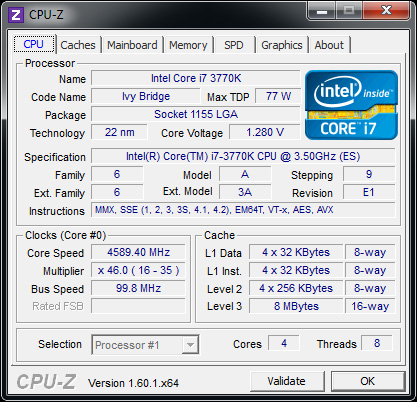The Intel Ivy Bridge (Core i7 3770K) Review
by Anand Lal Shimpi & Ryan Smith on April 23, 2012 12:03 PM EST- Posted in
- CPUs
- Intel
- Ivy Bridge
Overclocking and 22nm
In the old days, whenever Intel transitioned to a new manufacturing process it was accompanied by increased overclocking headroom thanks to the reduction in power consumption and increase in switching speed afforded by the new transistors. To be honest, it's surprising the ride has even lasted this long.

Intel's 22nm process (P1270) is the most ambitious yet. The non-planar "3D" transistors promise to bring a tremendous increase in power efficiency by increasing the surface area of the transistor's inversion layer. It's the vehicle that will bring Intel into new form factors in mobile, but we're around a year away from Haswell's introduction. Rather than 22nm being a delivery platform for Ivy Bridge, it feels like Ivy Bridge is being used to deliver 22nm.

The process is still young and likely biased a bit towards the lower leakage characteristics of lower voltage/lower wattage CPUs, such as those that would be used in Ultrabooks. These two factors combined with some architectural decisions focused on increasing power efficiency result in what many of you may have heard by now: Ivy Bridge won't typically overclock as high as Sandy Bridge on air.
The frequency delta isn't huge. You'll still be able to hit 4.4—4.6GHz without resorting to exotic cooling, but success in the 4.8—5.0GHz range will be limited to water alone for most. Ivy Bridge is also far more sensitive to voltage than Sandy Bridge. Heat dissipation can increase significantly as a function of voltage, so you'll want to stay below 1.3V in your overclocking attempts.
Dr. Ian Cutress, our own Senior Motherboard Editor, put Ivy Bridge through a pretty exhaustive investigation if you want more details on exactly how the chip behaves when overclocking and how best to overclock it.
For the past few years I've been focused on power efficient overclocking. I'm looking for the best gains I can get without significant increases in core voltage. With my 3770K I was able to reliably hit 4.5GHz with only a 140mV increase in core voltage:

The end result is a 15—28% overclock, accompanied by a 32% increase in power consumption. The relationship between overclock speed and power consumption actually hasn't changed since Ivy Bridge, at least based on this datapoint.
| Ivy Bridge Overclocking | |||||
| Intel Core i7 3770K | Stock | 4.6GHz Overclock | % Increase | ||
| Load Power Consumption | 146.4W | 204W | 39.3% | ||
| x264—2nd Pass | 41.8 fps | 49.5 fps | 18.4% | ||
As always, your mileage may vary depending on the particular characteristics of your chip. Ivy Bridge can be overclocked, but at least initially it's not going to be as good of an overclocker as Sandy Bridge. Over time I expect this to improve somewhat as Intel's 22nm process matures, but by how much remains a question to me. It's unclear just how much of these limits are by design vs. a simple matter of process maturity.











173 Comments
View All Comments
jmcb - Saturday, May 12, 2012 - link
I was thinking the exact same thing.I waited long to jump on the dual core bandwagon, 2008 with a C2D 8400. I havent jumped on the quad core wagon yet. Was waiting for them to run cooler.
This seems like a good time to make the jump.
CeriseCogburn - Friday, June 1, 2012 - link
I'm going to get rid of my 2500K @ 4.8GHz , because it's HD3000 just isn't doing it for BF3,and I'm going Trinity man !
See me and my amd apu on the gaming servers !
a. totally wanna be cool amd fan
b. fantasy boy with lunch money from mommie in pocket
c. bonkers
d. all the above
p05esto - Monday, April 23, 2012 - link
Yea, but WHEN can I buy one? Forgive me if I missed that all important detail. My desktop is 2.5 yrs old and am ready to upgrade here. Show me where to buy, lol.Catalina588 - Monday, April 23, 2012 - link
OEM boxes arrive April 29th. I expect NewEgg will have parts shortly thereafter.tiki037 - Wednesday, April 25, 2012 - link
+1I thought the April 23 launch date meant that was when we would be able to buy one.
Tommyv2 - Monday, April 23, 2012 - link
Why no benchmarks against a 2700K, you know - a real platform comparison? I'm guessing it's exactly the same performance?Anand Lal Shimpi - Monday, April 23, 2012 - link
Working on testing the 2700K now - didn't have one at the time that the CPU tests were conducted, the difference is small as you can guess, will add results to bench as they are completed.Take care,
Anand
Ratman6161 - Monday, April 23, 2012 - link
...but really, they already have large quantities of benchmarks of the 2600K and the difference between that and 2700K is going to be relatively meaningless...my guess, not worth the trouble of running the whole suite of benchmarks on it. To my knowledge, the only difference is 100 MHz of clock speed, right?deadsix - Monday, April 23, 2012 - link
Any chance Anand that we get a 35W Quad Core processor for laptops like the Macbook Pro 13"Kristian Vättö - Monday, April 23, 2012 - link
There is i7-3612QM which is a 35W 2.1GHz quad core. Whether Apple uses it is another question, though.http://www.anandtech.com/show/5772/mobile-ivy-brid...